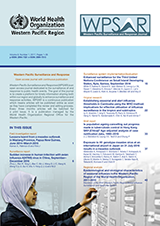Epidemiological and virological characteristics of seasonal influenza in the Western Pacific Region of the World Health Organization, 2011–2015
DOI:
https://doi.org/10.5365/wpsar.2017.8.1.004Abstract
Seasonal influenza causes yearly epidemics throughout the world and is a major cause of morbidity and mortality. Influenza surveillance systems have been in place throughout the Western Pacific Region of the World Health Organization for many years and continue to evolve. The virological and epidemiological data reported to WHO from this region were examined for the period 2011 to 2015 and compared with data from a prior summary from 2006 to 2010. Reporting increased substantially, approximately 10-fold, between 2006 and 2015, particularly following the 2009 A(H1N1)pdm09 pandemic. Data were aggregated into four zones based on geographic location and exhibited seasonal trends. Analyses of the data showed seasonal trends and periods of heightened influenza activity in the northern temperate zone, China, and the southern zone. There were no clear seasonal trends in the tropical zone. Collection and analysis of influenza surveillance data are important to guide influenza vaccination policy and recommendations, especially regarding viral subtypes to be included in vaccines and identification of groups that are at particularly high risk of influenza infections. Additionally, these data allow for a comprehensive overview of seasonal influenza in the region and evaluate how surveillance systems in the region have evolved.
References
World Health Organization. Immunization, Vaccines and Biologicals - Influenza 2008 [Available from: http://www.who.int/immunization/topics/influenza/en/.
Finkelman BS, Viboud C, Koelle K, Ferrari MJ, Bharti N, Grenfell BT. Global patterns in seasonal activity of influenza A/H3N2, A/H1N1, and B from 1997 to 2005: Viral coexistence and latitudinal gradients. PLoS One. 2007;2(12):e1296.
Viboud C, Alonso WJ, Simonsen L. Influenza in tropical regions. PLoS Medicine. 2006;3(4).
Rambaut A, Pybus OG, Nelson MI, Viboud C, Taubenberger JK, Holmes EC. The genomic and epidemiological dynamics of human influenza A virus. Nature. 2008;453:615-9.
World Health Organization. Countries and areas 2016 [Available from: http://www.wpro.who.int/countries/en/.
Russell CA, Jones TC, Barr IG, Cox NJ, Garten RJ, Gregory V. The global circulation of seasonal influenza A (H3N2) viruses. Science. 2008;320:340-6.
World Health Organization. Influenza - GISRS and laboratory 2016 [Available from: http://www.who.int/influenza/gisrs_laboratory/en/.
Barr IG, McCauley J, Cox N, Daniels R, Engelhardt OG, Fukuda K, et al. Epidemiological, antigenic and genetic characteristics of seasonal influenza A(H1N1), A(H3N2) and B influenza viruses: basis for the WHO recommendation on the composition of influenza vaccines for use in the 2009-2010 northern hemisphere season. Vaccine. 2010;28(5):1156-67.
World Health Organization. FluNet 2016 [Available from: http://www.who.int/influenza/gisrs_laboratory/flunet/en/.
World Health Organization. FluID - a global influenza epidemiological data sharing platform 2016 [Available from: http://www.who.int/influenza/surveillance_monitoring/fluid/en/.
World Health Organization. Asia Pacific strategy for emerging diseases: 2010: World Health Organization; 2011.
Members of the Western Pacific Region Global Influenza Surveillance and Response System. Epidemiological and virological characteristics of influenza in the Western Pacific Region of the World Health Organization, 2006-2010. PLoS One. 2012;7(5):e37568.
Jiang L, Lee VJ, Lim WY, Chen MI, Chen Y, Tan L, et al. Performance of case definitions for influenza surveillance. 2015.
Durand LO, Cheng PY, Palekar R, Clara W, Jara J, Cerpa M, et al. Timing of influenza epidemics and vaccines in the American tropics, 2002-2008, 2011-2014. Influenza Other Respir Viruses. 2016;10(3):170-5.
Zhen X, Pavlin B, Squires RC, Chinnayah T, Konings F, Lee C-K, et al. Ebola preparedness in the Western Pacific Region, 2014. WPSAR. 2015;6(1):66-72.

